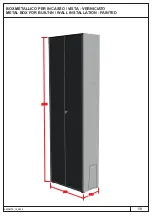
33
W W W . B A L T I M O R E A I R C O I L . C O M . A U
M A R 2 1 0 - 2
RC SERIES
Cold Weather Operation
INSPECTION AND MAINTENANCE
FAN SECTION ICING PROTECTION
BASIN WATER AND INTERNAL PIPING FREEZE PROTECTION
COIL FREEZE PROTECTION
NOTE:
Modulating the water
flow rate to the unit is NOT a
recommended method of
controlling cooling capacity.
Inspection & Maintenance
BAC products can be operated at subfreezing ambient temperatures
provided proper operating methods are established and diligently followed.
• Carry out frequent visual inspections and routine maintenance
services during operation in subfreezing weather.
• Ensure all controls for capacity and freeze protection are set properly
and functioning normally.
• Prevent excessively high water levels and possible overflow of the
cold water basin due to over pumping, clogged strainers, or make-up
valve malfunction.
• Some unit icing can be expected in very cold weather. Usually this
will not affect the operation of the unit. Resolve any icing conditions
that may damage the unit or the supports, impair the system
performance, or create a safety hazard.
Fan Section Icing Protection
There are three basic operational methods which can be used to provide
the system’s required cooling: temperature setting, fan control, and
dry operation. The method of control employed on a given application
depends upon the climatic extremes which are expected, the variations
in heat load that will be encountered, and the compatibility of the control
system with other portions of the installation.
In subfreezing ambient temperatures, effective icing control may require
a combination of these three methods. Operate each unit with the
highest thermal load it can handle, rather than evenly dividing the total
heat load across all cells. During prolonged cold weather periods, bypass
the idle units and drain the basins.
Temperature Setting (RCF Only)
Low leaving fluid temperatures promote ice formation. During operation in
subfreezing ambient temperatures, maintain the leaving fluid temperature
as high as possible. Ensure the unit operates with the maximum possible
heat load. The recommended process fluid temperature is 10°C for RCF
units with water (non-glycol) as the heat transfer liquid and 7.2°C for RCF
units with glycol as the heat transfer liquid.
Fan Control
Reduce the unit capacity by cycling the fans, thus modulating the
airflow through the unit. Rapid on-off cycles can cause the fan motor to
overheat. Set the controls to allow a maximum of six on-off cycles per
hour. Periodically, cycle the fans off to prevent ice formation and/or to
melt ice that accumulates on the combined inlet shields.
Cold Weather Operation
Inspection & Maintenance
Fan Section Icing Protection
Temperature Setting
Fan Control






































